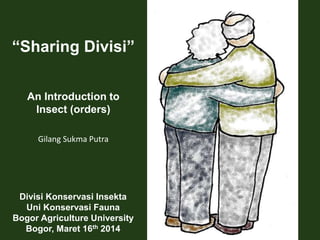This document provides an introduction to insect orders presented by Gilang Sukma Putra. It begins with illustrations showing insect mouthparts and orders. The main sections discuss the characteristics, distributions, habitats, and conservation statuses of different insect orders including Orthoptera (grasshoppers and crickets), Mantodea (mantises), Blattodea (cockroaches), and Hemiptera (true bugs). Examples of species from each order are illustrated. The document aims to educate about insect biodiversity and classification.





















































